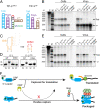5'-Cap sequestration is an essential determinant of HIV-1 genome packaging
- PMID: 34493679
- PMCID: PMC8449379
- DOI: 10.1073/pnas.2112475118
5'-Cap sequestration is an essential determinant of HIV-1 genome packaging
Abstract
HIV-1 selectively packages two copies of its 5'-capped RNA genome (gRNA) during virus assembly, a process mediated by the nucleocapsid (NC) domain of the viral Gag polyprotein and encapsidation signals located within the dimeric 5' leader of the viral RNA. Although residues within the leader that promote packaging have been identified, the determinants of authentic packaging fidelity and efficiency remain unknown. Here, we show that a previously characterized 159-nt region of the leader that possesses all elements required for RNA dimerization, high-affinity NC binding, and packaging in a noncompetitive RNA packaging assay (ΨCES) is unexpectedly poorly packaged when assayed in competition with the intact 5' leader. ΨCES lacks a 5'-tandem hairpin element that sequesters the 5' cap, suggesting that cap sequestration may be important for packaging. Consistent with this hypothesis, mutations within the intact leader that expose the cap without disrupting RNA structure or NC binding abrogated RNA packaging, and genetic addition of a 5' ribozyme to ΨCES to enable cotranscriptional shedding of the 5' cap promoted ΨCES-mediated RNA packaging to wild-type levels. Additional mutations that either block dimerization or eliminate subsets of NC binding sites substantially attenuated competitive packaging. Our studies indicate that packaging is achieved by a bipartite mechanism that requires both sequestration of the 5' cap and exposure of NC binding sites that reside fully within the ΨCES region of the dimeric leader. We speculate that cap sequestration prevents irreversible capture by the cellular RNA processing and translation machinery, a mechanism likely employed by other viruses that package 5'-capped RNA genomes.
Keywords: 5′ cap; HIV-1; RNA; genome; packaging.
Copyright © 2021 the Author(s). Published by PNAS.
Conflict of interest statement
The authors declare no competing interest.
Figures





Comment in
-
Show your cap or be packaged into HIV-1.Proc Natl Acad Sci U S A. 2021 Oct 5;118(40):e2115344118. doi: 10.1073/pnas.2115344118. Proc Natl Acad Sci U S A. 2021. PMID: 34583998 Free PMC article. No abstract available.
Similar articles
-
Unpaired Guanosines in the 5' Untranslated Region of HIV-1 RNA Act Synergistically To Mediate Genome Packaging.J Virol. 2020 Oct 14;94(21):e00439-20. doi: 10.1128/JVI.00439-20. Print 2020 Oct 14. J Virol. 2020. PMID: 32796062 Free PMC article.
-
Role of RNA structural plasticity in modulating HIV-1 genome packaging and translation.Proc Natl Acad Sci U S A. 2024 Aug 13;121(33):e2407400121. doi: 10.1073/pnas.2407400121. Epub 2024 Aug 7. Proc Natl Acad Sci U S A. 2024. PMID: 39110735 Free PMC article.
-
Identification of a minimal region of the HIV-1 5'-leader required for RNA dimerization, NC binding, and packaging.J Mol Biol. 2012 Mar 30;417(3):224-39. doi: 10.1016/j.jmb.2012.01.033. Epub 2012 Jan 27. J Mol Biol. 2012. PMID: 22306406 Free PMC article.
-
Structural determinants and mechanism of HIV-1 genome packaging.J Mol Biol. 2011 Jul 22;410(4):609-33. doi: 10.1016/j.jmb.2011.04.029. J Mol Biol. 2011. PMID: 21762803 Free PMC article. Review.
-
HIV-1 RNA genome packaging: it's G-rated.mBio. 2024 Apr 10;15(4):e0086123. doi: 10.1128/mbio.00861-23. Epub 2024 Feb 27. mBio. 2024. PMID: 38411060 Free PMC article. Review.
Cited by
-
Anomalous HIV-1 RNA, How Cap-Methylation Segregates Viral Transcripts by Form and Function.Viruses. 2022 Apr 29;14(5):935. doi: 10.3390/v14050935. Viruses. 2022. PMID: 35632676 Free PMC article. Review.
-
Translation of unspliced retroviral genomic RNA in the host cell is regulated in both space and time.J Cell Biol. 2025 Apr 7;224(4):e202405075. doi: 10.1083/jcb.202405075. Epub 2025 Jan 27. J Cell Biol. 2025. PMID: 39868815 Free PMC article.
-
Infectious RNA: Human Immunodeficiency Virus (HIV) Biology, Therapeutic Intervention, and the Quest for a Vaccine.Toxins (Basel). 2022 Feb 14;14(2):138. doi: 10.3390/toxins14020138. Toxins (Basel). 2022. PMID: 35202165 Free PMC article. Review.
-
Human immunodeficiency virus 1 5'-leader mutations in plasma viruses before and after the development of reverse transcriptase inhibitor-resistance mutations.J Gen Virol. 2023 Oct;104(10):001898. doi: 10.1099/jgv.0.001898. J Gen Virol. 2023. PMID: 37801004 Free PMC article.
-
HIV-1 transcription start sites usage and its impact on unspliced RNA functions in people living with HIV.mBio. 2025 Feb 5;16(2):e0357624. doi: 10.1128/mbio.03576-24. Epub 2024 Dec 27. mBio. 2025. PMID: 39727416 Free PMC article.
References
-
- Coffin J. M., Hughes S. H., Varmus H. E., Retroviruses (Cold Spring Harbor Laboratory Press, Plainview, NY, 1997). - PubMed
-
- Berkowitz R., Fisher J., Goff S. P., RNA packaging. Curr. Top. Microbiol. Immunol. 214, 177–218 (1996). - PubMed
-
- Paillart J.-C., Shehu-Xhilaga M., Marquet R., Mak J., Dimerization of retroviral RNA genomes: An inseparable pair. Nat. Rev. Microbiol. 2, 461–472 (2004). - PubMed
Publication types
MeSH terms
Substances
Grants and funding
LinkOut - more resources
Full Text Sources
Research Materials
Miscellaneous

